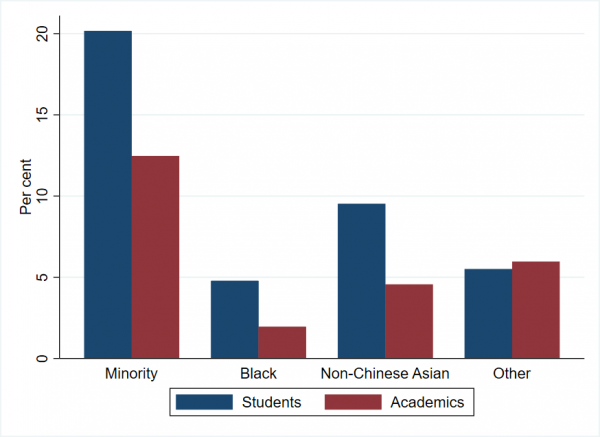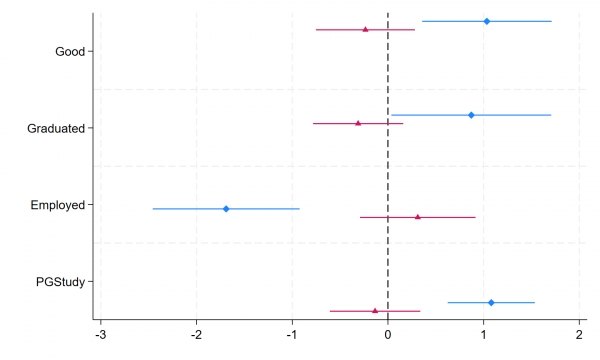Minority and own-race staff improve the academic outcomes of minority students including the probability of graduating at all, on time, and with a good degree, and for progression into post-graduate study.
The research
Racial minority students at UK universities are less likely to complete their degree on time or at all, to get a good degree class, and to be employed soon after graduation than White students. Minorities are also considerably underrepresented among university academic staff, relative to their share among students. We investigated whether minority students exposed to more minority staff, do better at and after university than they would otherwise.
Data
We linked the Higher Education Statistics Agency (HESA)’s Student Records and Staff Records, with HESA’s Destination of Leavers from Higher Education (DLHE) survey. The Records are administrative datasets including information about the whole population of students and staff registered with UK universities. We used information on all students enrolling in undergraduate courses between 2012 and 2014, and follow them until they drop out, complete their studies, or until the academic-year-beginning 2017. DLHE is a survey that was sent to all graduates from UK universities, approximately six months after completion, to collect information about their further education activities, whether they were in employment, and if so, details about their job.
We keep all universities except the Open University, and all subjects except Medicine and Dentistry. Our final population for analysis includes over 640,000 entering students, of whom over 428,000 complete their degree.
Methods
We calculate the share of academic staff who are from any minority group, or who are Black, non-Chinese Asian, and of other racial groups, in each university department and each academic year. We measure each student’s ‘exposure’ to minority or to same-race academic staff using their department of study in their first academic year at university.
We then compare the educational and labour market outcomes of students on otherwise-similar courses at similar universities (in terms of UCAS tariff score typically required for entry), who are exposed to different proportions of minority or same-race staff. We control for a rich set of other student and staff characteristics, as well as permanent differences between subjects, and universities, and cohorts. This removes the potential for our findings to be driven by factors other than staff ethnicity.
We also carry out several checks in order to rule out our results being driven by (for example) the students we would expect to have better outcomes anyway, self-selecting onto courses with more minority or same-race staff.
Findings
A 10 percentage point (pp) increase in the share of minority academic staff increases the probability that a minority student will:
- graduate with a good degree (upper-second or first-class) by 1pp
- graduate on time, or graduate at all, by 0.9pp.
- once graduated, progress into any further study by 1.4pp and postgraduate study by 1.1pp
However, 10pp increase in the share of minority staff reduces the probability that a minority student will be employed six months after graduation by 1.7pp. For those who are employed, there is no significant impact on whether their job is a graduate-level or high socio-economic status job. We find similar benefits of same-race representation for Black and non-Chinese Asian students.
We find no evidence of minority staff representation significantly impacting the academic outcomes of White students, but for those who graduate and find employment, has a significant positive impact on securing a graduate-level job.

Figure 1 Share of minority staff and students at UK universities, 2012-2017
Notes See Table A1 at https://doi.org/10.1016/j.labeco.2025.102745 for data source and sample details.

Figure 2 Impact of 10pp increase in minority staff on education and labour market outcomes of minority (blue diamonds) and White (red triangles) students, pp
Notes See Tables 3 and 4 at https://doi.org/10.1016/j.labeco.2025.102745 for data source and sample details.
What does this mean for policy makers?
Minority and own-race staff improve the academic outcomes of minority students including probability of graduating at all, on time, and with a good degree, and for progression into post-graduate study.
Increased minority progression to academic careers may feed through to a virtuous cycle of relative improvements in minority students’ degree completion and degree class. If this increases diversity in research and development industries, this may increase innovation in non-academic settings (Parrotta et al., 2014).
We find no detrimental effects, and benefits to job attributes, of exposure to minority staff for White students. This is consistent with the more diverse environment inculcating prosocial attitudes that are perceived favourably during students’ job search (Bartenen & Grissom, 2023; Wells et al., 2016).
However, on average, for those students who do graduate, there are no beneficial effects of minority and own-race staff on the early labour market outcomes of ethnic minority students. This suggests the benefits of same-race representation among academic staff for minority students in UK universities, result from these staff acting as role models and providing advice and guidance that are all specific to academic contexts. This may not reflect the full spectrum of viable career options for these students, and may steer them into courses and a delayed labour market entry that does not pay off.
About the authors
Dr Angus Holford is a Senior Researcher at the Institute for Social and Economic Research at the University of Essex, and leader of the Education and Formation of Skills Strand of the ESRC Research Centre on Micro-Social Change.
Dr Sonkurt Sen is a Postdoctoral Researcher in the Department of Economics at the University of Bonn and a Research Associate at the ESRC Research Centre on Micro-Social Change at ISER.
Further information
Full paper
Holford, A., Sen, S., (2025), ‘Racial Representation among Academics and Students’ Academic and Labour Market Outcomes’. Labour Economics, https://doi.org/10.1016/j.labeco.2025.102745
Cite
Holford, A., Sen, S., (2025), Minority staff improve the academic outcomes of minority students at UK universities. MiSoC Explainer 10.5526/misoc-2025-004, University of Essex.
Further information
For further information about this research, please contact Louise Cullen, Head of Communications and Engagement at the Institute for Social and Economic Research, University of Essex, at lcullen@essex.ac.uk.
References
- Bartenen & Grissom, 2023. ‘School Principal Race, Teaching Racial Diversity, and Student Achievement’. Journal of Human Resources 58:2, 667-712
- Parrotta et al., 2014, ‘The nexus between labor diversity and firm’s innovation’. Journal of Population Economics, 27, 303- 364
- Wells et al., 2016. How racially diverse schools and classrooms can benefit all students. The Century Foundation
Acknowledgements and disclaimers
Research supported by the Economic and Social Research Council (ESRC) through grants ES/S012486/1, ES/ M008622/1 and ES/P00072X/1 and by the German Research Foundation (DFG) through CRC TR 224 (Project A05). This research uses data from HESA Student Records, Staff Records and Destination of Leavers from Higher Education Survey which are available under license for specified research projects. Access to the data must be restricted to named researchers, and outputs must comply with certain statistical disclosure controls. We will assist those who would like to obtain the data for replication purposes. Data are copyright Higher Education Statistics Agency (HESA) Limited. Neither HESA Limited nor HESA Services Limited can accept responsibility for any inferences or conclusions derived by third parties from data or other information supplied by HESA Limited or HESA Services Limited.
© MiSoC June 2025
DOI: 10.5526/misoc-2025-004
